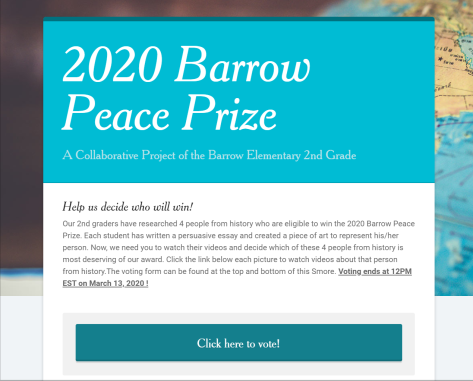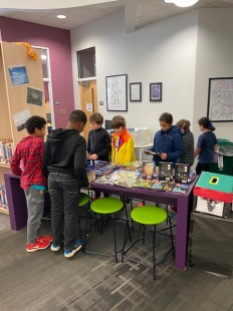
Our 4th grade is currently exploring Lewis & Clark, the Corps of Discovery, the impact on Native Lands, and westward expansion. To support their study, they asked me to put together some ideas for students to build some background information on the topics. I loved that our author visit with Nathan Hale really served as a starting place for this unit of study because he told an entire Hazardous Tale about Lewis and Clark.

After looking over the 4th grade social studies standards, resources in the library, and online resources, I decided to create 4 centers that students would rotate through.
SS4H3 Explain westward expansion in America.
-
- Describe the impact of westward expansion on American Indians; include the Trail of Tears, Battle of Little Bighorn and the forced relocation of American Indians to reservations.
- Describe territorial expansion with emphasis on the Louisiana Purchase, the Lewis and Clark expedition, and the acquisitions of Texas (the Alamo and independence), Oregon (Oregon Trail), and California (Gold Rush and the development of mining towns).
I created a brief organizer for students to gather some information as they visited each center.
Center 1
Students visited an interactive map of westward expansion. The map allowed them to select Native Lands and Trail Routes as features and then look at those across time. The main purpose of this station was for students to see how Native Lands disappeared or moved from 1790-1850 and to speculate why they thought there was a change. Students had not studied this time in history yet so they were making predictions or using previous knowledge of events such as the Trail of Tears.
While students were at this center, I walked around and helped them select the most helpful features before they explored clicking lots of map features. The teacher and I also got to listen to their ideas of why Native Lands moved or changed over time.

This center had a part 2 that most students weren’t able to get to. It included another interactive map where students could match primary documents to locations on a map.
Center 2
At this center, students traveled to the Library of Congress through a virtual Lewis and Clark exhibit called “Rivers, Edens, & Empires“. Students could start at any point in the tour and look at the many artifacts from Lewis & Clarke and Westward Expansion. The artifacts included lots of maps, but students were most interested in clothing, tools, and weapons used.

Students read about any artifacts that interested them the most and gathered those artifacts onto their organizer.
Center 3

I gathered books from our library on the California Gold Rush, Westward Expansion, York and the Corps of Discovery, and Sacagawea. We also have a Capstone Interactive ebook of Lewis and Clark. At this center, students could read about any of the topics that interested them. Most students chose the interactive ebook, but a few spent time reading about other topics like Sacagawea. Whichever person or topic they chose to read, students gathered some facts that they discovered.

Center 4
For the final center, I wanted students to have an opportunity to look at the journals and sketches of Lewis & Clark as well as the animals that the Corps of Discovery saw along their travels. Students visited 3 sites to view the journals, see some more artifacts, learn about the animals, and even hear some of the animal sounds. Students created a list of animals that were interesting or that they had not heard of.

Management & Next Steps
I split the class up between the 4 centers with about 6 students at each center. Students had 8-10 minutes per center, which took us right up to time to leave. We didn’t have time to come back together for a closing, but I decided since this was a lesson on building background info that the knowledge gained could go back into the classroom for the next lessons and we could use our full time for exploring. Students also spent time talking and sharing at the tables so it seemed repetitive to have them share information one more time.

Teachers will now continue to add information to expand on the topics students scratched the surface of in the library. I’m sharing a bit.ly with teachers so students can revisit any of the resources we explored in the library.

I loved doing this type of exploration at the beginning of the unit because it really gives students control of their learning and is more interactive than just presenting information on slides or a shared text. I hope more opportunities will arise where we can explore topics in this way in the library.


















































































































































